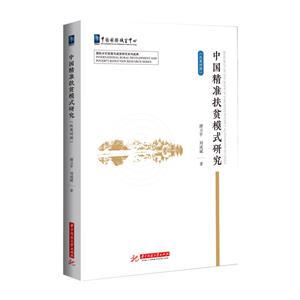預估到手價是按參與促銷活動、以最優惠的購買方案計算出的價格(不含優惠券部分),僅供參考,未必等同于實際到手價。
-
>
蜜蜂的寓言:私人的惡德,公眾的利益
-
>
世界貿易戰簡史
-
>
日本的凱恩斯:高橋是清傳:從足輕到藏相
-
>
近代天津工業與企業制度
-
>
貨幣之語
-
>
眉山金融論劍
-
>
圖解資本論
中國精準扶貧模式研究(漢英對照) 版權信息
- ISBN:9787568075824
- 條形碼:9787568075824 ; 978-7-5680-7582-4
- 裝幀:一般膠版紙
- 冊數:暫無
- 重量:暫無
- 所屬分類:>>
中國精準扶貧模式研究(漢英對照) 本書特色
本書重點關注貧困這一熱點問題和中國精準扶貧這一重大社會實踐方略,以社會復雜系統、社會耦合、等值功能主義、系統理性等理論為框架,創新性的從社會學的視角對中國精準扶貧模式進行二階觀察,論證模式高效運行的何以可能,為模式的精準性、時效性、創新性提供深度的理論釋解。
中國精準扶貧模式研究(漢英對照) 內容簡介
本書以盧曼的社會系統論為理論基礎,從精準扶貧的理論淵源和實踐經驗入手,首先梳理新中國成立以來實施的扶貧政策,分析政策內容和特點,總結不同階段的扶貧模式;其次從組織力量系統、互動系統、社會監督和考核系統、整體幫扶系統四個方面分析了精準扶貧的政策體系,包括責任體系、措施體系、投入體系、幫扶體系、社會動員體系、監督體系、考核評估體系等;再次從系統理性出發,分別論證精準識別、精準幫扶、精準管理、精準考核四個方面的生成邏輯、實踐模式以及典型經驗,然后在此基礎上,從理論來源、理論界定、理論結構、理論意義四個方面對中國精準扶貧模式進行分析,同時對印度、巴西和墨西哥的精準扶貧實踐進行比較剖析,得出其中的經驗,*后在形成系統性的理論的基礎上,科學分析后扶貧時代精準扶貧的新方向和世界減貧工作的未來發展。
中國精準扶貧模式研究(漢英對照) 目錄
上篇 中文部分
**章 緒論3
一、研究背景及意義3
二、文獻綜述4
三、概念界定及理論基礎13
四、研究方法16
五、操作路線17
第二章 二階觀察與中國扶貧政策變遷18
一、整體模式扶貧:以體制改革促進扶貧階段(1978—1986年)18
二、開發模式扶貧:區域開發式扶貧階段(1986—1992年)19
三、經濟模式扶貧:市場經濟針對性反哺的項目制扶貧階段(1993—2000年)20
四、行動模式扶貧:以村莊為基礎的參與式扶貧階段(2001—2012年)21
五、社會扶貧模式:精準扶貧階段(2013—2020年)23
六、精準扶貧策略的特征分析25
第三章 等值功能主義與精準扶貧政策體系30
一、互動系統31
二、組織力量系統35
三、整體幫扶系統38
四、社會監督與考核系統40
第四章 系統理性與精準扶貧實踐方略45
一、精準識別子系統:追求公平正義45
二、精準幫扶子系統:注重協調發展48
三、精準管理子系統:重視制度創新51
四、精準考核子系統:堅持系統思維53
五、小結56
第五章 全面耦合:中國精準扶貧模式分析57
一、理論來源:結構與系統57
二、理論界定:系統與耦合58
三、理論結構:四重耦合59
四、理論意義:社會整合與融合66
第六章 系統理論與典型國家扶貧比較68
一、印度的扶貧經驗69
二、巴西的扶貧經驗73
三、墨西哥的扶貧經驗78
四、典型國家扶貧經驗比較82
第七章 總結與展望84
一、精準扶貧政策的社會成效84
二、精準扶貧策略的社會創新性89
三、精準扶貧與后扶貧時代的脫貧鞏固問題93
四、發展中國家扶貧工作建議與世界減貧的未來96
參考文獻99
下篇 英文部分
Chapter One:Introduction109
ⅠResearch Background and Significance109
ⅡLiterature Review111
ⅢDefinitions and Theoretical Basis125
ⅣResearch Method130
ⅤTechnology Route131
Chapter Two:Second-order Observation and the Changes of China’s
Poverty Alleviation Policies133
ⅠOverall Mode of Poverty Alleviation: Promoting Poverty
Alleviation through System Reform (1978-1986)134
ⅡDevelopment Mode Poverty Alleviation: Regional Development
Stage of Poverty Alleviation (1986-1992) 135
ⅢPoverty Alleviation in the Economic Mode: Project-based Poverty
Alleviation Stage of Targeted Feedback from Market Economy(1993-2000)137
ⅣAction Mode for Poverty Alleviation: Villagebased Participatory
Poverty Alleviation stage(2001-2012) 139
ⅤSocial Mode for Poverty Alleviation: Targeted Poverty Alleviation
Stage (2013-2020)141
ⅥAnalysis of the Characteristics of Targeted Poverty Alleviation
Strategies146
Chapter Three:Equivalent Functionalism and the System of Targeted Poverty Alleviation Policy155
ⅠInteractive System156
ⅡSystem for Organizing Forces164
ⅢIntegrated Poverty Alleviation System170
ⅣSocial Supervision and Assessment System174
Chapter Four: Systematic Rationality and Strategy of Targeted
Poverty Alleviation Practice182
ⅠAccurate Identification Subsystem: Pursuing Fairness and Justice182
ⅡThe Subsystem of Targeted Poverty Alleviation: Focusing on
Coordinated Development188
ⅢThe Subsystem of Accurate Management: Attaching Importance to
System Innovation192
ⅣThe Subsystem of Accurate Assessment: Adhering to Systematic
Thinking197
ⅤSummary201
Chapter Five: Comprehensive Coupling: Analysis of China’s Targeted
Poverty Alleviation Mode203
ⅠTheoretical Source: Structure and System203
ⅡTheoretical Definitions: System and Coupling205
ⅢTheoretical Structure: Quadruple Coupling206
ⅣTheoretical Significance: Social Integration and Unity219
Chapter Six: The Comparison between System Theory and Poverty
Alleviation in Typical Countries221
ⅠIndia’s Experience in Poverty Alleviation222
ⅡBrazil’s Experience in Poverty Alleviation228
ⅢMexico’s Experience in Poverty Alleviation235
ⅣComparison of the Experience of Poverty Alleviation in
Typical Countries241
Chapter Seven: Summary and Prospect244
ⅠThe Social Effectiveness of Targeted Poverty Alleviation Policies244
ⅡThe Social Innovation of Targeted Poverty Alleviation Strategies253
ⅢTargeted Poverty Alleviation and the Consolidation of Poverty
Alleviation in the Post-poverty Era259
ⅣPoverty Alleviation Proposals for Developing Countries and the
Future of Poverty Reduction in the World263
Reference268
中國精準扶貧模式研究(漢英對照) 作者簡介
譚衛平,經濟學博士,中國國際扶貧中心副主任。在原國務院扶貧辦系統工作達26年,先后擔任原國務院扶貧辦國際合作司副司長、行政人事司副司長。2002年至2005年作為第四批援疆干部擔任新疆維吾爾自治區扶貧辦副主任。譚衛平博士是國家公務員局和國務院學位辦授予的“全國公共管理專業研究生教育校外導師”,曾擔任國務院學位辦高校博士點評審評委。他承擔了大量中國對發展中國家中、高級官員培訓的授課任務,直接聽課的發展中國家官員超過三千人次。曾公開出版《中國企業在東南亞投資的減貧效果分析》《國際減貧理論與前沿問題2020》《世界各國減貧概要(第二輯)》等多部論著,組織編輯《國際減貧動態》、《中國扶貧開發年鑒》等多部刊物。譚衛平博士有豐富的對外減貧援助項目經驗,主持東亞三國減貧示范合作技術援助項目的設計、實施與管理;還是世界銀行-中國扶貧貸款項目的負責人。
- >
詩經-先民的歌唱
- >
回憶愛瑪儂
- >
朝聞道
- >
上帝之肋:男人的真實旅程
- >
推拿
- >
羅曼·羅蘭讀書隨筆-精裝
- >
姑媽的寶刀
- >
經典常談















